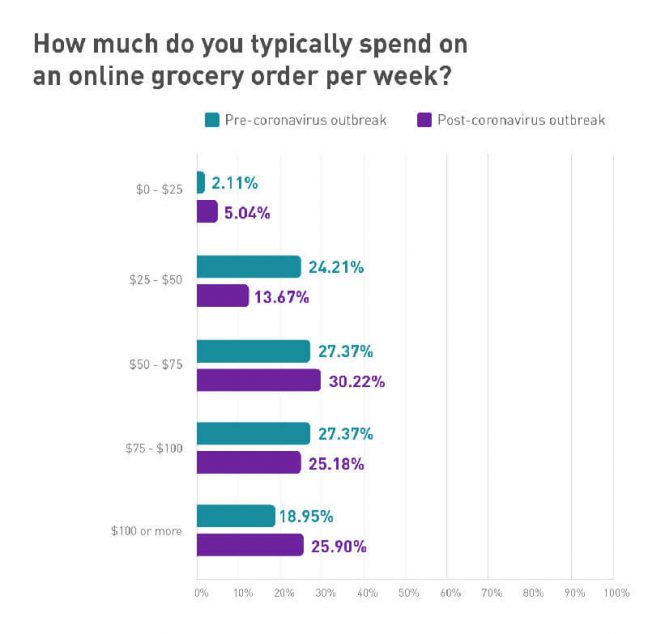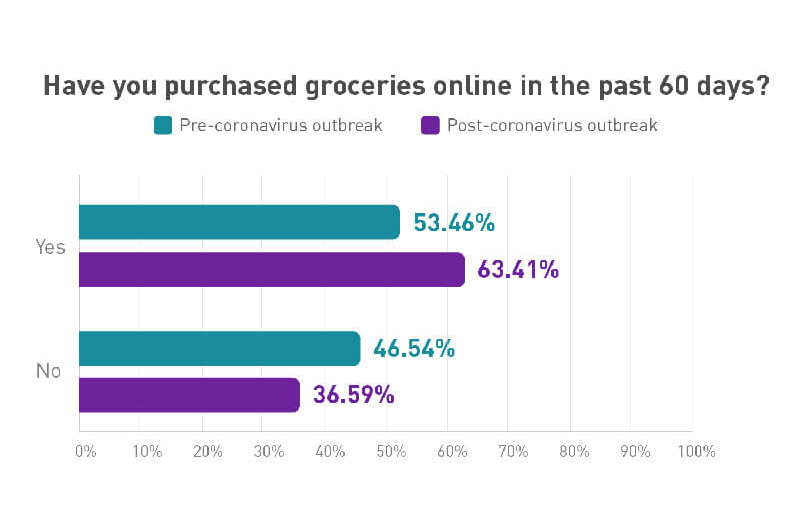Chicory has released the results of a new grocery consumer research study, quantifying the impact of the coronavirus on online grocery usage. The study shows that consumers are both shopping online for groceries more frequently and also checking out with bigger baskets.
Online grocery usership grew in general. In April, 17 percent more survey respondents answered that they completed an online grocery purchase within the last 60 days, compared to January.
Frequency of purchases increased. The number of respondents who completed an online grocery purchase once a week or once a month grew by 17 percent. 
Purchase size increased. A total of 24 percent more respondents answered that they spent $50-plus per order post-outbreak and 37 percent more respondents spend over $100 per weekly grocery trip. This suggests that consumers are both shopping online for groceries more frequently and also checking out with bigger baskets.
When examining the intersection of respondents who shop weekly for groceries online and how much they spend, the data indicates that consumers may be replacing their regular in-store grocery trips with online orders. Thirty-one percent more respondents shop weekly for groceries online post-outbreak.
One major change that the study revealed is that consumers are 56 percent more likely to build their online grocery shopping lists on a weekly basis, or add to their lists every few days, rather than daily or every few weeks. This indicates that shoppers are sitting down and planning their online grocery shop rather than building a list passively over time, again mimicking habits of brick-and-mortar shoppers.
Finally, the survey examined which retailers consumers choose for online grocery shopping: 28 percent more shoppers chose Instacart as their preferred retailer post-outbreak with the marketplace gaining the largest share of new users. Features like broad retailer availability and educated product substitution amid stocking issues may have contributed to its popularity.
The results from this study are from a pre- and post-coronavirus outbreak consumer study conducted by Chicory. Chicory surveyed 1,600 grocery shoppers, once pre-coronavirus outbreak (January 2020) and then again post-outbreak (April 2020) and compared the results in order to determine the impact of the pandemic on changing consumer behavior in the grocery sphere.
“Research has shown that foot traffic has dropped at some grocery stores by nearly 40 percent and consumers are stretching out the time between their in-store grocery shops,” said Yuni Sameshima, Chicory’s CEO and co-founder. “Since they’re not visiting brick and mortar for their groceries as often, many are turning to online grocery services in order to continue their regular grocery shopping frequency during the coronavirus pandemic. What will be interesting will be observing how much the industry will adjust to keep up with online grocery demand, as it’s notoriously expensive for retailers. But with consumers spending much more online than they had been and on larger individual orders, online grocery is set to become a part of American households’ regular habits.”
Chicory is an New York City-based tech firm and an expert in content-to-commerce for grocery. Its signature “Get Ingredients” button can be found on more than 1,450 recipe websites, including Taste of Home, Delish, Betty Crocker and thousands of influencer food blogs. Leveraging its extensive recipe network, Chicory partners with leading CPG brands like General Mills and grocery retailers like Wakefern to serve hyper-relevant ads to consumers in the moments when they’re planning their grocery purchases.

